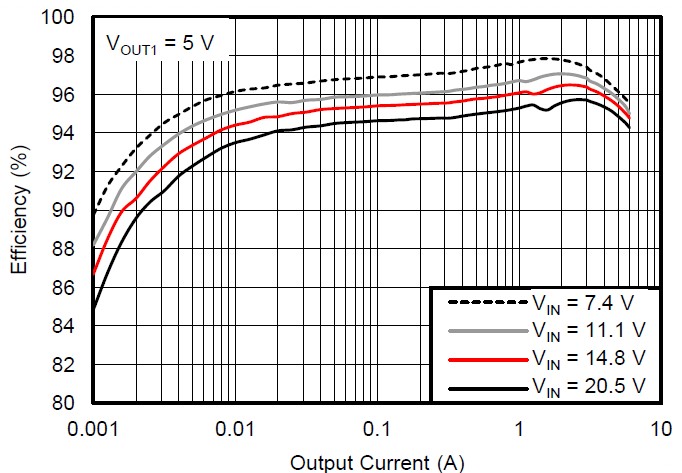SLUAA54B May 2020 – May 2021 TPS51206 , TPS51215A , TPS51220A , TPS51285A , TPS51396A , TPS51716 , TPS543B20 , TPS54424 , TPS54824 , TPS54A24 , TPS65295 , TPS82130 , TPS82140 , TPS82150 , TPSM41615 , TPSM41625 , TPSM84824
- Trademarks
- 1Suggested Tiger Lake Point-of-Load Solutions
- 2Light Load Efficiency (Eco-Mode™) and Low Quiescent Current (ULQ™)
- 3Voltage Identification (VID) Capability with TPS51215A
- 4Fast Load Transient Response with D-CAP3™ and D-CAP2™ Control
- 5Small IC Packaging
- 6Conclusion
- 7Resources
- 8Revision History
2 Light Load Efficiency (Eco-Mode™) and Low Quiescent Current (ULQ™)
The POL regulators generating low voltages from an array of batteries must employ an energy-saving pulse-skipping technique now referred to as Eco-Mode. The inductor current in a synchronous-buck converter is a triangle wave. As the output current decreases from a heavy-load condition, the inductor current is reduced and the rippled valley of the triangle wave eventually touches the zero level at the boundary between continuous conduction-mode (CCM) and discontinuous conduction node (DCM). With Eco-Mode, the rectifying MOSFET is turned off when the converter detects zero current in the inductor. As the load current further decreases, the on-time is held nearly constant so that the off-time is extended, and the switching frequency is reduced to maintain regulation. As a result, the power MOSFETs and inductor are idle for longer time periods and conduction losses are greatly reduced. DC/DC converters and controllers with low quiescent current will have improved light-load efficiency performance and extended battery run-time, since less power is dissipated within the IC. The TPS51825A features Ultra Low Quiescent current (ULQ) of 25-uA for longer battery life in system stand-by mode. Figure 2-1 shows 90% efficiency with 7.4-V input and 5-V output at 1-mA, illustrating the combined affects of Eco-Mode and ULQ.
 Figure 2-1 TPS51285A Efficiency Plot
Figure 2-1 TPS51285A Efficiency Plot